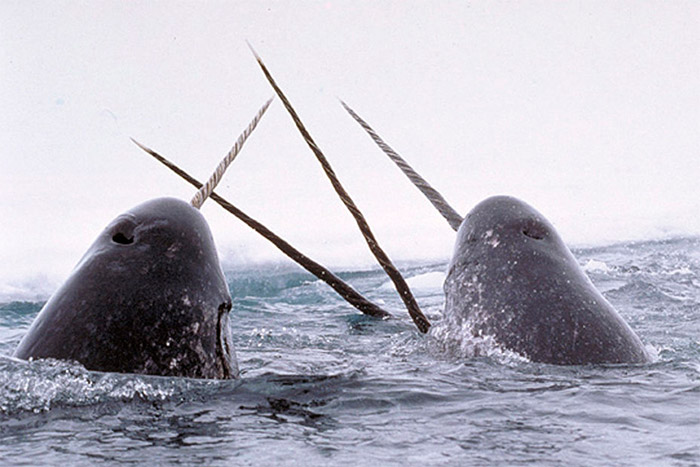Unicorn Whale (Narwhal)

The narwhal is called the “unicorn of the sea” or “unicorn whale”. It is a pale-colored porpoise found in Arctic coastal waters and rivers. In males, the more prominent of the narwhals two teeth grows into a sword-like, spiral tusk. The ivory tusk tooth grows right through the narwhal’s upper lip, giving it the look of a unicorn.
Brief Description of the Unicorn Whale or Narwhal
Narwhals are related to other porpoises such as bottlenose dolphins, belugas, harbor porpoises, and orcas. Like some other porpoises, they travel in groups and feed on fish, shrimp, squid, and other aquatic fare. They are often sighted swimming in groups of 15 to 20. However, gatherings of hundreds or even several thousand narwhals have been reported.
Like the beluga, narwhals are medium-sized whales. For both sexes (excluding the male’s tusk), the total body size can range from 13.0 to 18.0 feet (3.95 to 5.5 metres). The males are slightly larger than the females. The average weight of an adult narwhal is 1,800 to 3,500 pounds (800 to 1,600 kilograms). At around ages 11 to 13 years old, the males become sexually mature. Females however become sexually mature at about 5 to 8 years old. Narwhals do not have a dorsal fin, and their neck vertebrae are jointed like those of other mammals, not fused as in dolphins and most whales.
What do Narwahl Eat?
Narwhals have a fairly restricted and specialized diet. Their prey is mostly composed of Greenland halibut, polar/Arctic cod, cuttlefish, shrimp and armhook squid. However other items found in the stomachs of narwhal have included wolffish, capelin, skate eggs and even rocks. Narwhals are believed to feed by swimming towards prey until it is within close range and then sucking it with considerable force into the mouth.
One study published in the Canadian Journal of Zoology tested 73 narwhals of different age and gender to see what they ate. The study conducted in 1978 found that the Arctic cod made up approximately 51% of the diet of the narwhals, with the next most common animal being the Greenland halibut (consisting of 37% of the weight of their diet). Deep-water fish such as halibut, redfish and polar cod have also been found in the diet of the males. This means that the narwhals can dive deeper than 1,600 ft (500 m) below sea level. The study also found that the dietary needs of the narwhal did not change among genders or ages.
Narwhal Tusks
The most prominent feature of the male narwhal is a single long tusk, which is actually a canine tooth that projects from the left side of the upper jaw, through the lip and forms a left-handed helix spiral. Their tusks grow throughout their life, reaching lengths from roughly 4 ft 11in to 10 ft 2in (1.5 to 3.1 m). The tusk is actually hollow and weighs around 22 lbs (10 kg).
Some males (about one in 500) has two tusks. This occurs when the right canine also grows out through the lip. Females sometimes grow tusks as well. However only about 15 percent of females have a tusk and their tusks are smaller than those of males and also have a much less noticeable spiral.
The tusk is actually a sensory organ and has millions of nerve endings connecting seawater stimuli in the ocean environment to the brain. New studies of also suggest that the tusk has a role in “mate choice” and is used as a mechanism for sexual selection in addition to previously understood “male-to-male rivalry“. Narwhals have rarely been observed using the tusk for aggressive behavior.
Where Do Narwhal Live?
Narwhal are found predominantly in the Atlantic and Russian areas of the Arctic Ocean. They are commonly recorded in the northern part of Hudson Bay, Hudson Strait, Baffin Bay; off the east coast of Greenland; and in a strip running east from the northern end of Greenland round to eastern Russia. However, most of the world’s narwhals are concentrated in the fjords and inlets of Northern Canada and western Greenland.
Are Narwhals Endangered?
According to the World Wildlife Federation, Narwhals are listed as “Near Threatened”.
Narwhals natural predators are polar bears and orcas. In addition native Inuit people are also allowed to hunt this whale legally.
The narwhal’s tusk has been valued for many years by humans. It is often said to be the origin of the myth of the unicorn. During the Middle Ages the tusk was used to cure epilepsy, strengthen the heart, induce perspiration, and also buffer poison. A narwhal tusk was also one of the most prized possessions of Queen Elizabeth I. Narwhals are also important to many Eskimo cultures. The meat is used for sled dogs, and the skin is an important source of Vitamin C. It is a chewy delicacy is called “muktuk”. While human demand for Narwhal tusks and meat has been reduced in modern times, there are other threats facing the Narwhal such as habitat, climate change, and increased shipping traffic.
The narwhal’s habitat is threatened by both pollution and climate change. Other factors including their small population size, limited range, and reliance on Arctic fish (which are also being affected by climate-induced available food changes), make them extremely vulnerable. One recent study concluded that the narwhal might be even more sensitive to the impacts of climate change than the polar bear.
Additional threats include oil and gas development. This increased development means more shipping vessels, which creates more opportunities for collisions and more underwater noise that can interfere with communication among the whales.
Current population estimates in the Northwest Atlantic region are thought to be around 50,000. However, worldwide estimates are not available. There are still over 1,000 narwhals killed each year between Canada and Greenland. These numbers are believed to be above a sustainable level.
